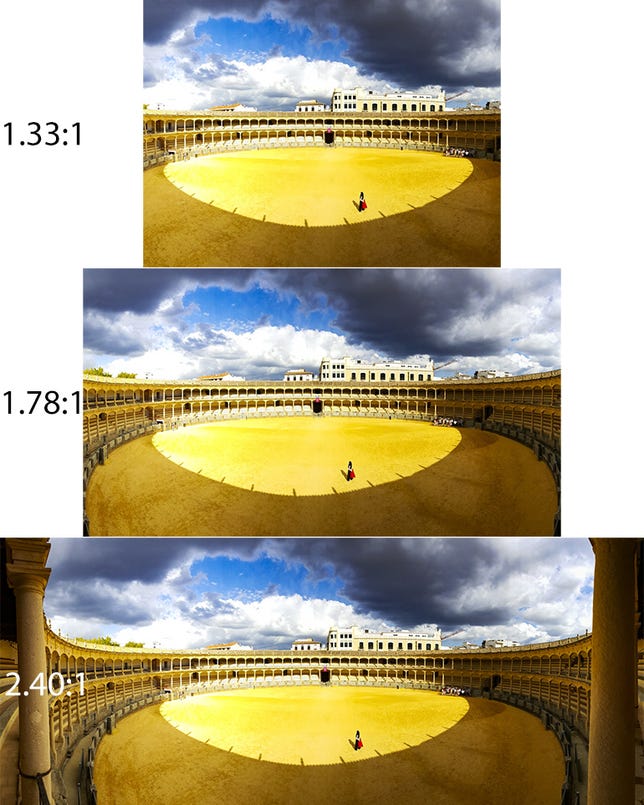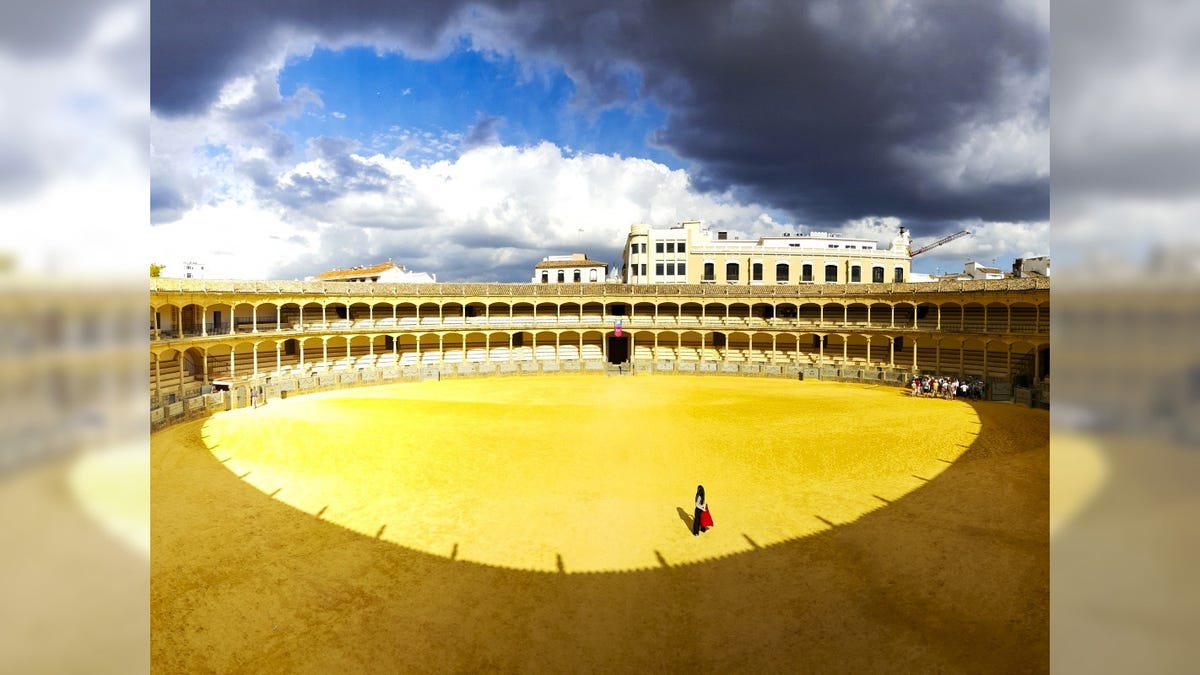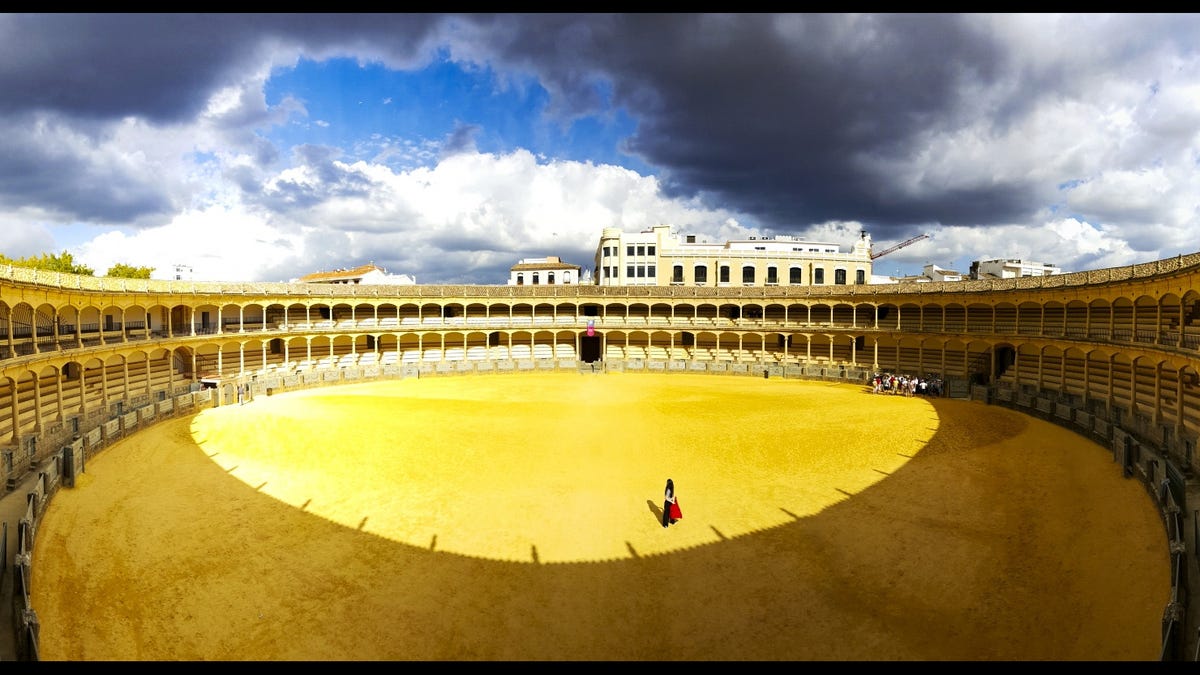Ever watch a movie, and get distracted by the black bars at the top and bottom of the screen? Ever wonder what they are, and why they’re different sizes? Wasn’t the switch to “widescreen” TVs supposed to prevent all this?
Well…yes and no.
The problem is there’s still often a difference between how wide a TV show or movie is, and how wide your TV is. Black bars get added — to the sides or top and bottom of the screen — so the TV show or movie can fit on your TV without bring cropped or stretched. Some people find these bars distracting, but they’re a good thing.
Here’s why.
Wide, wider, widest

 Enlarge Image
Enlarge ImageNote how much is lost when cropping the original image (bottom) to fit screens with a squarer aspect ratio.
Geoffrey Morrison/CNET
“Aspect ratio” is the ratio of the width of a rectangle to its height.
A perfect square has an aspect ratio of 1×1, or 1:1. A rectangle that’s twice as wide as it is tall would have an aspect ratio of 2×1, or 2:1.
Things start getting a little confusing when you have stranger ratios. For example, the old tube-style TVs were slightly wider than they were tall. They had an aspect ratio of 4×3, which could also be described as 1.33:1 (technically, 1.33333333333…:1 but let’s not get too crazy).
If it’s been a while since you’ve seen a tube TV (try a cheap hotel…), another really common 4:3 device is the iPad.
Your HDTV is even wider. It has an aspect ratio of 16×9, or 1.78:1 (again, 1.7777…). So for every 16 inches wide your TV screen is, it’s 9 inches tall.
Old TV shows generally have an aspect ratio of 4×3. In order to fit them on your wider screen, 16×9 HDTV, something has to give. You can’t fit a square peg in a rectangular hole, so to speak.
The easiest way is to put bars on the left and right. ESPN, for example, does this a lot with old footage, putting their logo on the right and left. Nightly news shows often show a blurred out version of the image on either side of the “real” image.
Another, less ideal, way is to crop and zoom on the image, removing the top and bottom, but fitting the image on the 16×9 screen. This often removes things like foreheads.
Another even less ideal way to do it is to stretch the image horizontally. This makes everyone look exceptionally fat.


A common way to show 4×3 content on a 16×9 screen.
Geoffrey Morrison/CNET
If all you watched on your TV were current TV shows, with the occasional rerun of “Night Court” thrown in, you’d be all set. Old shows would have sidebars (“pillarboxing”), new shows would fill your TV.
The problem is movies. Hollywood has had many, many different aspect ratios over the years. These days the most common are 1.85:1, and 2.39:1. Depending on your favorite old movie, however, these could range from 1.37:1 (“Casablanca”) all the way to 2.76:1 (“Ben-Hur,” and more recently, “The Hateful Eight”).
Most Blu-ray and streaming services show these movies in their original aspect ratio, with either thick black “letterbox” bars at the top and bottom of 2.39:1 aspect movies (2.40:1 as it’s put on the Blu-ray):


A 2.40:1 image as shown on a 1.78:1 (16×9) HD/UHDTV. Bonus points if you can figure out what town this is in.
Geoffrey Morrison/CNET
Or with small letterbox bars when showing a 1.85:1 movie (comedies, some smaller dramatic films):


A 1.85:1 aspect ratio image as shown on a 1.78:1 (16×9) HD/UHDTV.
Geoffrey Morrison/CNET
So even though it seems like you’re seeing less image, you’re actually seeing the entire image. As in, everything the director intended you to see. Many directors use this format to its full advantage, putting important aspects of the story all over the screen, or setting up beautiful shots, all of which gets lost if the aspect ratio isn’t correct.
And sometimes the same film will actually employ different aspect ratios, often for effect. “Oz the Great and Powerful” switched from black-and-white 4×3 to color 2.35:1 after the protagonist moved to Oz, for example, and “Life of Pi” was a 16×9 film that included two changes, once during the flying fish scene and another in homage to the cover of the book. And for some films presented in IMAX, like “The Dark Knight” and “Tron: Legacy,” only certain portions were shot in the 1.44:1 IMAX format. Here’s a great collection with plenty of other examples.
Cropping and stretching
All TVs come with aspect ratio controls to zoom or stretch the image so it fills the screen. Often they buttons are labeled “wide” or “format.” These exist largely because people get upset that black bars cover the screen, thinking they weren’t seeing “the whole image” (even though, as we’ve discussed, they were).
Would you like too know more?
- What is upconverting?
- Can 4K TVs make ‘regular’ HD content look better?
- Beyond basic TV settings
- What’s the best picture mode?
- Overscan: You’re not seeing the whole picture on your TV
Some people are so annoyed by the black bars that they use the aspect ratio controls on their TV to crop and zoom in on the image.
This is a bad idea, for several reasons. We’ll skip the “director’s intent” argument because in all my years talking about the benefits of the correct aspect ratio, pleading “this is what the director wanted!” has convinced exactly zero people.
Here’s why: it makes your TV look worse. WAY worse.
It’s that simple. Zooming in on an image makes it look worse, namely softer and fuzzier, despite what TV shows and movies lead you to believe about the “magic” of zooming on an image (Suuuuure you can read that license plate from a security camera a mile away in the dark).
For an example, let’s take a 2.40:1 movie on Blu-ray. The image’s resolution is 1,920 by 800 (1,920/2.4=800). That’s 26 percent less resolution than a standard 16×9 HD image to start with, and you’re only selecting part of it when you zoom/expand to fill the screen. You’re essentially taking a 1,420×800 image (the 16×9 portion of the wider image), and blowing it up to fill a 1,920×1,080 screen. That’s 45 percent less resolution that your TV has to create, often poorly.

 Enlarge Image
Enlarge ImageOriginal (top) vs upconverted or “scaled” (bottom). Click for a larger image. I exaggerated it a bit so you could see the difference in lower resolution. This example image was created to show what Blu-ray looks like on 4K TVs, but the overall effect for cropping/zooming is similar (albeit less pronounced).
Geoffrey Morrison/CNET
By zooming in on this lower resolution image, there can be multiple issues depending on your TV. As mentioned, it’s always going to be softer than if you didn’t zoom in. That’s because no matter how good scaling has gotten, it still can’t work magic and make lower resolution images look like HD.
The second is the likeliness of “jaggies” or jagged diagonal lines. For more on that, and more examples of the effects of zooming in on an image, check out What is upconverting? and Can 4K TVs make “regular” content look better.
4K, 21:9, 16×10 and more
So far we’ve covered what most of you have, namely a standard HDTV. Ultra HD “4K” displays are the same aspect ratio, and will have the same issues when you zoom in, only worse. Scaling a Blu-ray image to look good on a 4K TV is one thing, but scaling a lower resolution image gets progressively harder, and will look progressively worse.


The Vizio CinemaWide XVT3D0CM was a 21×9 TV.
Sarah Tew
Every few years we see a manufacturer tout a wide-aspect ratio TV. Philips has marketed a few, and the Vizio CinemaWide XVT3D0CM was the last we reviewed at CNET. These had screen in a 21×9, or 2.33:1 ratio (though many were 2560×1080 resolution, which is usually 2.37:1). Like 16×9 TVs, this matched exactly no movie aspect ratios. However, they were close, and also offered the ability to have a full 16×9 image and something else (like a Web page) on screen at the same time. Don’t expect these to become mainstream.
Many computer monitors have a slightly taller aspect than TVs, with a 16:10 ratio.
There are a LOT more aspect ratios, most are less common today than the ones we’ve discussed.
Bottom line
Hey, it’s your TV, enjoy. But for the best picture quality, leave it in the original aspect ratio. Make sure your DVD, Blu-ray, or cable box is set to output 16×9, and make sure your TV is set for “native,” or something similar, in it’s aspect ratio settings (it’s usually the same control that helps you solve this problem).
The image may be smaller with letterbox bars, but by cropping and zooming, you’ll lose detail and potentially miss out on what’s on the sides of the image.
Got a question for Geoff? First, check out all the other articles he’s written on topics such as why all HDMI cables are the same, LED LCD vs. OLED vs. Plasma, why 4K TVs aren’t worth it and more. Still have a question? Tweet at him @TechWriterGeoff then check out his travel photography on Instagram.




